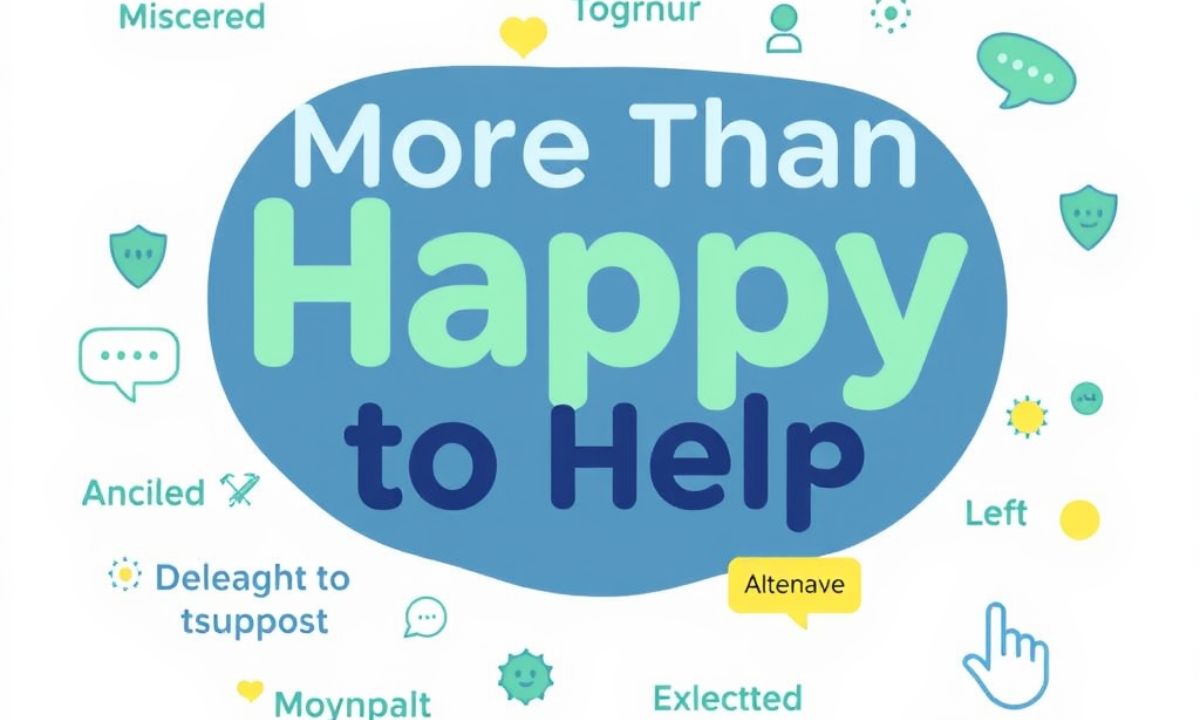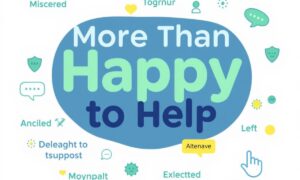Different synonym other than just ‘more than happy to help’ denotes that you actually love helping someone and keeping your language fresh and appealing.
Whether it is offering a customer service or open collaboration, or simply everyday interaction, learning these other expressions can show readiness for support and commitment to help.
This guide mines all possible different ways of expressing eagerness to help: to offer valuable options for any situation, including the formal tones required pastes about any circumstance needing informal support.
READ MORE: https://travelloverage.com/ways-to-say-including-but-not-limited-to/
How Can I Assist You?
The phrase “How may I assist you?” strikes the perfect balance between being professional yet approachable in a formal situation.
The statement conveys that you are ready and available to offer help to a customer while keeping an appropriate distance in your business interaction.
In any professional correspondence or in front of a client, it sets an atmosphere of competence and trustworthiness that brings confidence into the equation. Being an open-ended question, it allows the person to share their needs so that you know exactly how to help them.
Such an approach works beautifully in instances where clarity about what the other party expects is vital to positive outcomes.
Furthermore, this shows you as someone who values a good, efficient use of time and goes straight to the point about how you can be of help.
Example: Welcome to our service department; how can I assist you with your account today?
Ready to Lend a Hand
Telling someone that you are “ready to lend a hand” makes an instant “we’re part of a team” atmosphere whenever you need support.
This phrase beautifully expresses the willingness to help while sounding casual and friendly and being at ease with people. It shows readiness to jump right in without the usual hesitancies of colleagues or friends in trouble.
The informal nature of this phrase gives it the best effectiveness in team environments, where one values relationships as much as task completion.
This shows not only practical support but also emotional availability and thus can enrich one’s personal and professional contacts.
Also, this phrase invokes proactive engagement over passive availability; it indicates to other people that you’re ready to jump into action right now.
Example: I woke up and noticed you multi-deadlining the week with lots of deadlines; I’m ready to lend a hand with those reports whenever you need me.
What Can I Do for You?
A simple, direct question like “What can I do for you?” fosters clarity in communication and shows your willingness to help with something specific.
Such a direct question is free of ambiguity and focuses right on understanding a person’s needs, especially in the case of something requiring urgency.
In this way, you create an image of being solution-driven and concerned with real-world results rather than simply being polite.
Such a direct approach is deemed appropriate in every setting, such as board meetings, presentations, meetings with clients, meetings with suppliers, and all types of customer-service-related interactions.
This very request gives authority back to the other person to articulate the kind of assistance he or she will find to be the most helpful.
Such respect for self-governance strengthens working relationships by confirming your willingness to extend any help that one would want.
Example: I’ve got a little time this afternoon; what can I do to help you meet this deadline?
You Can Count on Me
You are taking a responsibility that does follow through with lifetime commitments whenever you say to someone, “You can count on me.”
This phrase does represent the house of bricks behind which it seals the people’s lives. This is a promise about the strength which breaks on the point of reliance and joins them together.
Particularly in one for professional matters, this may open up great responsibilities over others and, on very high times, among supervisors by opening the argument about accountability as something serious.
The phrase facilitates psychological safety in the recipient: they may continue confidently because they know that the support does not fail at any moment.
Using this expression in memorable moments is an agent of proving your integrity and follow-through in capturing dreams and relationships in one’s career.
This is of considerable value against uncertainty and during hard times because it encourages the weakened ones emotionally and physically.
Example: You can count on me to have all the research compiled by Thursday for the upcoming client presentation.
No Problem. Let Me Help
This statement of assurance and action: “No problem. Let me help,” makes a viable expression of support in several scenarios.
One then proceeds from having all the concerns about imposing and creating burdens lifted to a ready offer of assistance. In particular, where colleagues or clients struggle to offer help, this kind of expression ensures one sets up psychological safety by literally dismantling fences and normalizing hundreds of thousands of pouring much-needed assistance into other colleagues or clients.
This is really an informal, casual way of pinning down support-an approach that creates very comfortable interactions when other parties feel valued, not judged for requiring assistance.
Further, the text shows emotional intelligence because it anticipates possible fears with solutions.
Use this phrase repeatedly, and then you will swiftly begin to be known as someone who greets requests positively instead of with reluctance or bitterness.
Example: I mean, it is no bother at all really. Let me help you get through these new features so you can explore using them.
Find More Words!
With a wider array of good phrases, you can customize configuration styles to avoid making similar linguistic patterns throughout your expressions.
It also takes a lot of time to build a nice inventory of helper phrases for really committing yourself to effectiveness in communication and relationship building in the personal and the professional worlds.
It is good to ensure that the expressions of assistance vary from situation to situation, making the conversations more interesting, fresh, and sincere, even in routine situations.
That flexibility in language shows that you have emotional intelligence, which comes with an appropriate read of social contexts and the ability to customize your tone or phrasing according to what each interaction requires.
It also keeps the offers varied enough so that they don’t sound mechanical through repetition but that the person gets very clearly what kind of help you’re offering.
Finally, whenever you develop your vocabulary of supportive words, it leads to better overall communications while also showing that you are keeping abreast of details and aware of the people with whom you are interacting.
Example: Let me increase my ways of extending help by putting ‘I’d be delighted to support you with this project’ in place of my usual phrases.
Eager to Support You
Conveying something like, “I’m eager to assist you,” reveals enthusiasm and an active quest for solutions, making the offer a assist a real foray into engagement rather than fulfilling an obligation.
That statement carries deep emotional resonance, suggesting that the benefit that comes from lending the helping hand brings you fulfillment, rather than being a burden or source of annoyance. In a working context, this expression positions you as someone who brings positive energy and investment in every collaborative opportunity to collective success.
This forward-leaning expression shows initiative and proactive thinking, which are among the most esteemed qualities in today’s working environment.
When speaking with clients, this expression instills faith in your devotedness to service and builds rapport with its personal, engaged tone.
Thus, the phrase implies that you are also competent and ready, promising assistance for which you have the appropriate skills and wisdom.
Example: I’m eager to support you with the website redesign project, especially for the user experience components.
Happy to Extend a Hand
It has a nice emotional touch, but at the same time by using this, it is also an easily tangible connection.
This phrase thus is a great example of the balanced emotional and practical assists one needs to be effective while building relationships that will necessarily be as important as the problem solving itself.
The visual metaphor of extending a hand makes possible an image of connection and support that resonates at both conscious and subconscious levels as far as recipients are concerned. In workplaces, for example, this may help build up a culture of collaboration and mutual support because giving assistance here has been cast in the terms of positive, beneficial interactions and not a burdensome one.
For instance, this phrase might be used in customer service version to give a human touch to your help, which can thereby differentiate it from others seen as mechanical or routine responses.
Furthermore, the phrase successfully works across hierarchies making it apt for offering help to both superiors and juniors.
Example: This prospect is something that I’m happy to extend a hand with made to market research analysis, before next week’s presentation.
Offer Help Anytime
When you let someone know that you are available to “Offer help anytime,” it is a kind of open invitation with the time barrier being removed facet of incredible commitment to assisting others.
This kind gesture extends support way beyond immediate concern, setting the stage for an ongoing supportive relationship in which others could count upon whenever they need.
The relaxation of time constraints in this phrase represents extraordinary dedication that goes beyond standard professional obligations, making recipients feel exceptionally valued and supported.
In team contexts, this fosters psychological safety where colleagues feel liberated to reach out whenever challenges arise instead of struggling alone in silence.
It shows extraordinary emotional intelligence because it acknowledges that needs for assistance may arise quite unexpectedly and outside the normal working hours or contexts.
In client or customer-facing situations, it creates a wow service experience that drives loyalty and good word-of-mouth referrals.
Example: Feel free to get in contact with me and offer help anytime if you run into issues during the implementation phase of the new system
Willing to Assist You
The statement, “I will be pleased to assist you,” is an ideal expression for formal situations wherein the person has to keep up some distance in order to maintain professional decorum.
It conveys direct but clear intentions without overpromising or setting unrealistic expectations, thus being within limitations of capacity or role.
An organization can use this statement to uphold the hierarchical structure of the organization while offering genuine assistance within the confines of formality and limits.
This use of “willing,” which has a really subjective relationship, is voluntary and that which brings about a clearer positive basis for this helping endeavor.
As a narrative, it records and documents all those offers, but from the corporate tone appropriate for business recordkeeping.
This phrase also happens to be one of the best that transcends cultures because it is suitably translated in international businesses since it would be misconstrued or regarded inappropriate for some countries if it becomes more flowery.
Example: It would indeed please me to help prepare the quarterly financial reports whenever you feel ready to begin.
Always Here to Help
This is a powerful guarantee that promises constant support for an individual, engendering trust and decreasing anxiety in all kinds of relationships, whether it is at work or in personal life.
It expresses itself beyond being there to help with a given chore in order to ensure that one will always be available as a dependable reference in the long run to value something.
It creates psychological safety as it takes away any ambiguity about future availability for support, meaning that they set off knowing with confidence there will be backup when needed.
In these situations, the expression touches a peak concerning customers: conversions change from transactional dealings within the premise toward connection-building with long-term benefits just by using such a message. When using the phrase with a team,
it creates a culture of support where individuals feel secure knowing that resources are available to them when challenges arise. In addition, however, showing being there for people is to convey involvement in their ultimate well-being, as well as development, beyond just project or task involvement per se.’
Example: Remember that, I am always here to help, if you have questions about the new client management system.
Can I Be of Service?
“Can I be of service?” has a thoughtful but slightly formal flavor for offering assistance, which especially fit professional situations or client-facing ones.
It puts help in a context of service that makes it even elevate beyond just doing a task. Instead, it is implied that such acts are really for a higher end or purposes.
In the business or customer setting, that becomes a stately experience indicating quality throughout your organization-and attention to detail.
The open-endedness of this question weighs respect for the personal agency against clearly stating availability and willingness to assist.
It models a form of servant leadership in that it shifts the focus to how casting into action some things by others matters in a directorial position.
Further, this expression is very much useful in a situation that demands discretion or sensitivity because the formality confers sufficient professional distance, but it is not at all withholding of an earnest offer to support.
Example: Can I be of service with regard to the upcoming board presentation you are preparing?
Conclusion
Mastering the many different ways in which one might say they’re prepared to help others is a very good communication skill that improves professional relations and personal interactions.
These considered substitutes for “more than happy to help” allow one to finely adjust one’s tone for a particular context while remaining sincerely supportive.
Whether the setting is formal-for-instance, customer assistance-in business or informal-helping a co-worker or friend-having several phrases from which to choose will keep your message fresh and genuine.
The awareness and sensitivity to nuances of the willingness to help is an important differentiating factor that further defines truly great communicators.
In today’s interconnected professional world, how one offers assistance is just as relevant as the help itself.
Employing these various ways in conversational flow helps you build more meaningful connections while simultaneously establishing yourself as someone who is genuinely invested in others’ success.
Remember that it is your consistency and reliability that reinforce the verbal offers of help, creating a reputation for standing by your word that is not just seen but felt by others.
As you use these phrases in your professional and personal life, you will probably also find that authentic offers of help not only benefit the recipient but also add joy to your own life and engage you in all your relationships.

I’m Irfan, an experienced SEO content and SEO specialist with 2 years of expertise, currently contributing to Al Jazeera News Website.












